A co-worker of mine recently posed this question to me:
“I am really curious why all these pitchers who throw 92 mph up in the zone 60% of the time with no iVB are so effective. My analytical mind understands it, but my baseball mind from the years I coached and played still doesn’t believe it’s sustainable.”
The pitcher he specifically had in mind was Kyle Harrison, San Francisco’s soft-tossing, fastball-heavy (61% usage) southpaw who has somehow parlayed his 92 mph, 9.5-inch iVB (Induced Vertical Break), 62% high-location four-seamer into a +11 Run Value pitch – it’s been the 10th-most valuable four-seamer in baseball this year by that metric.
I agree with my colleague’s sentiment. Hitters want to hunt fastballs, so in theory, elevated, low-velocity, low-ride fastballs should be unloaded upon.
But hitters aren’t unloading upon Harrison’s elevated four-seamers. Opposing hitters have posted a .237 average and .310 wOBA on his fastballs – both around or below league average – and they’ve done worse against fastballs in the upper third of the zone, posting a measly .200 average and .224 wOBA.
So, what’s going on here?
The answer lies somewhere in between approach angle and release point.
High-Riding Fastballs
Eno Sarris wrote a fascinating article for The Athletic during last season’s playoffs, discussing the transition from pitchers attempting to control the bottom of the zone to the top.
Sports is all about adjusting to your opponent. Hitters adjusted to low-zone pitches, so pitchers started elevating. Recently, there’s been some evidence to suggest hitters are improving against elevated fastballs with carry.
I think on a basic human game thoery level, hitters have become better vs. rising fastballs, but i'm not sold on *how* much. Linearity is important in this analysis, and there isn't much.
Only using the following fastballs:
20>IVB>17
Top 3rd of zone
98>MPH>95
6.4>RelHt>5.9 https://t.co/awCyRikRVL pic.twitter.com/T6ePaXBxEA— Cameron Levy (@levy_cameron) October 26, 2023
Typically, we associate high velocity and high ride with high stuff marks, good pitching model metrics, and better results. On the whole, I still believe that to be true — for example, check out this scatter plot from Jon Anderson:
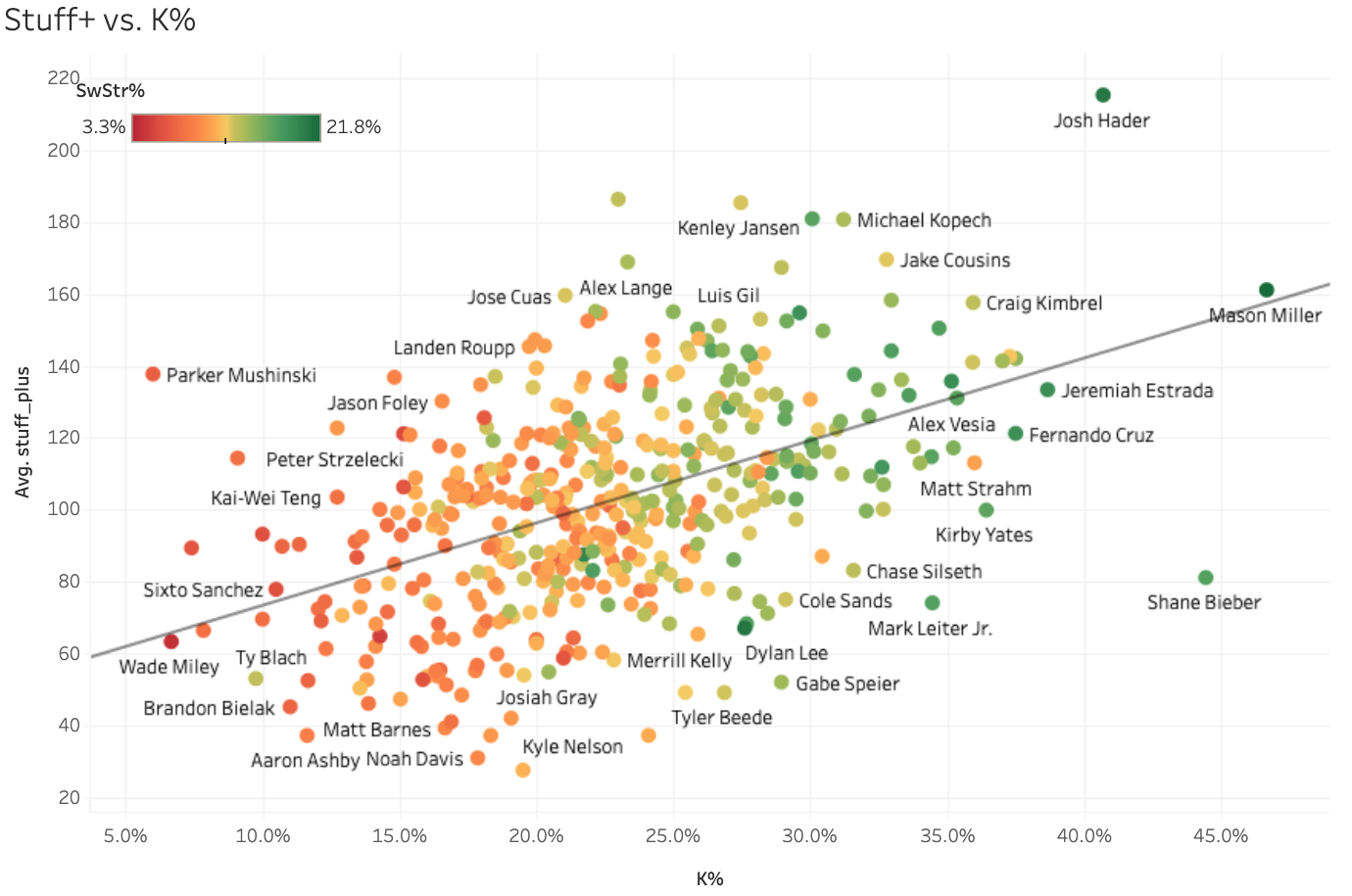
However, there are anomalies.
Approach Angles
So, all else being equal, a higher, flatter Vertical Approach Angle (VAA) – close to zero – on elevated fastballs equates to more whiffs. As described by Pitcher List:
“Vertical Approach Angle: The Angle at which a pitch approaches home plate vertically (in degrees). A high number is good for high fastballs, and a low number is good for low fastballs.”
As you can see below, the higher the approach angle, the higher the whiff rate (relative to the league average).
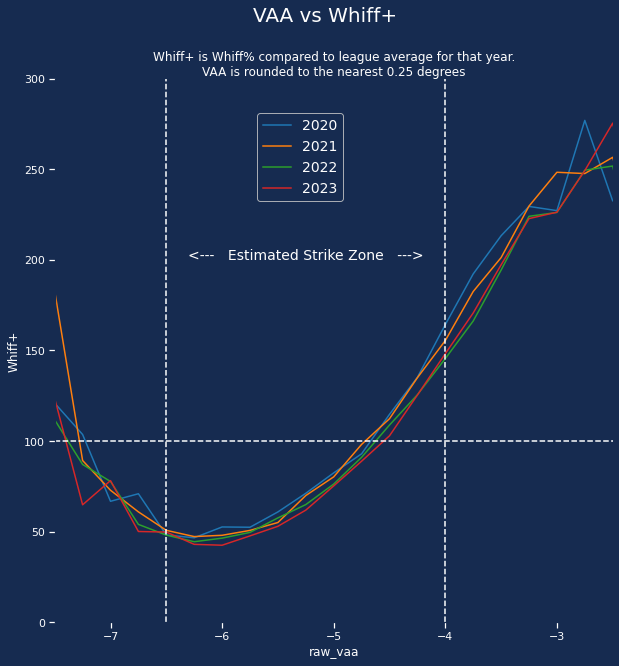
Hold on. Let’s back up for a second. What are you talking about with VAA, Tanner?
Consider the third-base-side view of a pitcher throwing a pitch toward the plate. Let’s say that pitcher throws a fastball toward the top of the zone, typically around 4.5 feet above the ground. Now, draw a line from the pitcher’s hand to where the pitch hits the plate — which we can do in a series of crude visual examples:

That “angle” there is the Vertical Approach Angle. Almost every pitch has to travel “downhill” from the pitcher’s hand to the plate, so nearly every approach angle will be negative in degrees. The bigger question with VAA is how negative this degree is. The league-average approach angle is around -4.8 degrees.
A steeper approach angle would mean the pitch is coming in at a more negative degree:

Conversely, a flatter approach angle would mean the pitch comes in at a less negative degree – i.e., closer to zero degrees or a flat line:

So, with this in mind, why are flatter approach angles better for elevated fastballs?
Nick Pollack and Kyle Bland of Pitcher List hypothesize that it’s because the number of intersection points is lower.
Hitters are most used to and prepared for a standard, league-average -4.8-degree VAA fastball. Therefore, those typical fastball paths will be more similar to, in line with, or parallel to the path of a typical swing. However, a flatter pitch will spend less time in the bat path, therefore having fewer locations where contact can be made. Thus, a flatter approach angle on elevated fastballs equates to more whiffs and better results.
That said, fastballs with super-high (flat) approach angles are likely way above the zone. Intuitively, that makes sense, given that the pitch will be almost too flat to travel downward from the release point to the plate.
Therefore, those pitches will generate fewer swings, resulting in above-the-zone balls. As you can see below, the swinging-strike rate jumps as the approach angle gets flatter, but eventually, it will drop where fastballs come in higher and higher.
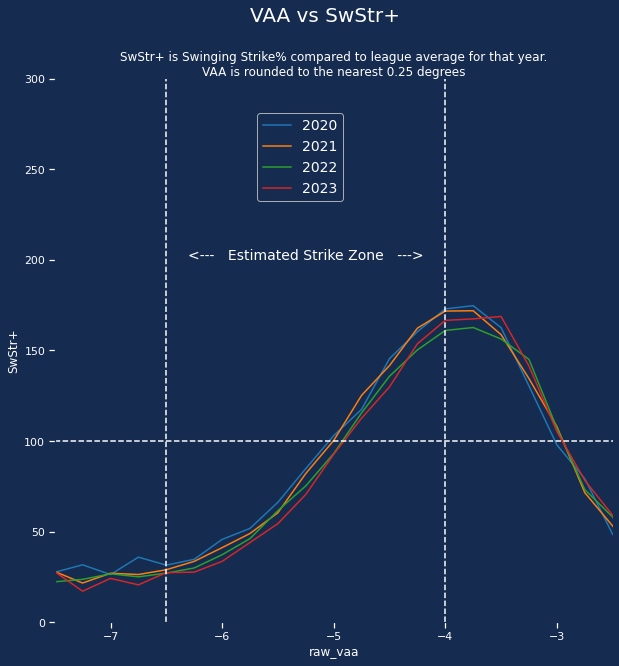
But do you see that hump? Right at the top of the estimated strike zone? That’s the sweet spot approach angle for high fastballs, where pitchers will generate the most upper-third swinging strikes. You need a flat fastball, but one that still travels a few degrees downward and hits the top of the zone.
Release Points
Let’s talk about release point.
Release point is pretty straightforward — it’s how high off the ground the pitcher releases his pitch. The league-average release point is 5.8 feet, with the lower end around four feet and the higher end around seven feet.
Obviously, release point will interact with approach angle. If you have a higher release point, your approach angle must be steeper to get the ball in the zone, and vice versa.
With that in mind, let’s talk about a pitcher with a super high release point, a guy whose motion comes in right over the top. Justin Verlander owns the highest arm slot in the game (min. 900 pitches thrown), with a release point hanging just over seven feet.
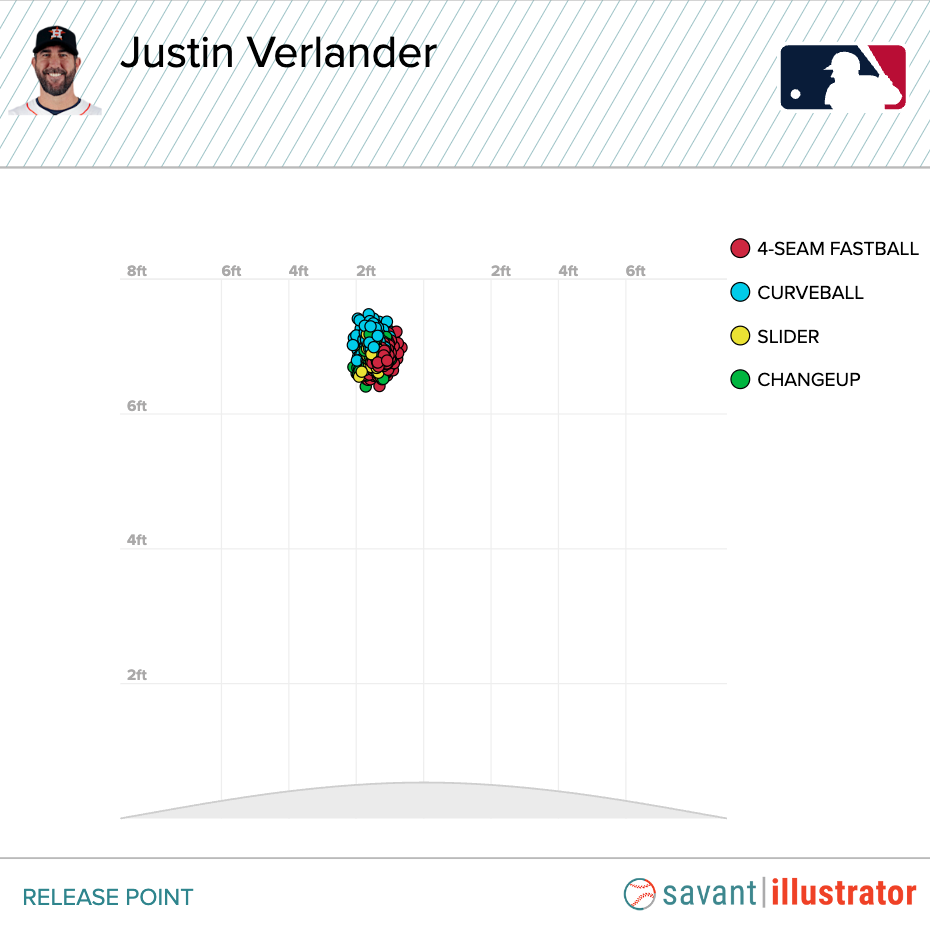
A high release point means you need a lower VAA (read: steeper) to get the pitch in the zone, and Verlander’s -5.5-degree VAA is lower than almost all of the game’s pitchers (fifth percentile). Otherwise, every single pitch will end up at eye level, and you’ll generate zero swings. For example, take this Verlander fastball to Nolan Arenado, which he released from his normal seven-foot release point but with an exceptionally flat approach angle:
However, as we’ve established, low VAA on high fastballs is bad because steeper approach angles result in fewer whiffs.
Well, unless you have wicked nasty stuff.
Luckily for Verlander, he has some of the nastiest stuff in the game. Verlander’s 19.3-inch iVB is among the highest in the sport (99th percentile), and although hitters are starting to fare better against carry, better stuff still equates to better results – he sports a 122 Stuff+ on his four-seam this season. J.P. Crawford had no shot at catching up with the ride on this four-seam, swinging right under it:
But, let’s say you’re Harrison. You throw 92 with no ride – his 9.5-inch iVB ranks in the fourth percentile of pitchers. How are you going to get hitters to swing under your four-seam?
On the contrary to Verlander, Harrison has a super low arm slot. Harrison’s 4.9-foot fastball release point is the fourth-lowest among 2024 MLB pitchers (min. 1000 pitches thrown).
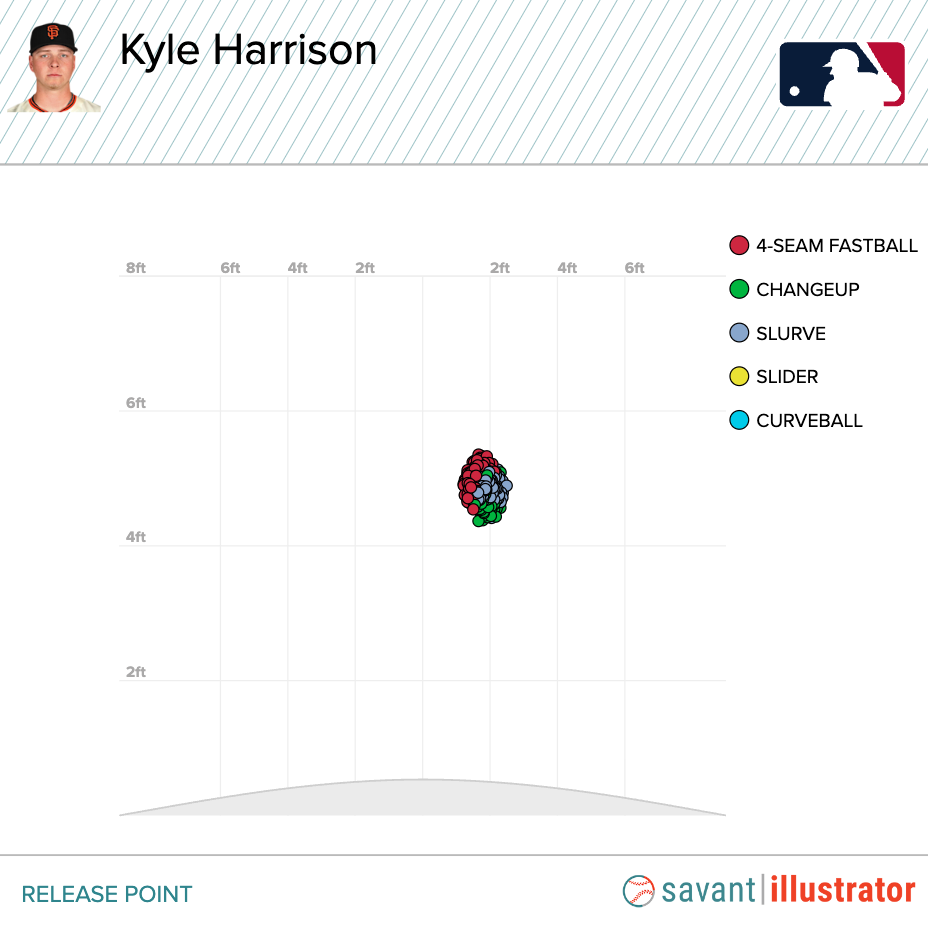
While players with high arm slots throw “down” to reach the zone, players with lower arm slots must throw “up” to reach the upper third, specifically with a lower VAA. Harrison has to throw to almost the exact location as his release point to elevate his fastball, thus with a flatter VAA, which – as we’ve established – is associated with more whiffs.
This fastball is pretty flat, giving Jose Altuve almost no intersection points:
Harrison’s average VAA is directly on the aforementioned hump. His -4.2-degree VAA on his four-seam fastball is exactly where hitters will make elevated swings and misses. If you’re a guy with less impressive fastball stuff, locating right around the top of the zone will help your low-stuff fastball play up.
The Right-Handed Harrison
So, as mentioned, Harrison’s fastball hasn’t been too bad. The 21% whiff rate isn’t crazy, but it’s above average (63rd percentile), and he’s done a solid job managing contact with it. But he’s been borderline-dominant with fastballs elevated to the upper third of the zone.
Harrison boasts a 62% high-location rate on the fastball, ranking in the 85th percentile of MLB pitchers. He throws it up in the zone, which plays because of a flat approach.
However, aren’t most fastballs more effective when elevated to the upper third? Yes, but the league-wide data is more fuzzy. Harrison’s difference is stark enough compared to the league-wide difference that I believe his elevated, flat-fastball approach to be somewhat significant.
The right-handed version of Harrison would be Paul Sewald. Sewald throws a 91 mph fastball with a 12-inch iVB, although the Stuff+ model grades it above average (114).
Still, almost nobody elevates his fastball more than Sewald, who boasts a 67% high-location rate on the pitch (94th percentile). And almost nobody has a lower release point, at 4.5 feet (second percentile). Thus, his -3.4-degree VAA is flatter than almost any fastball (99th percentile).
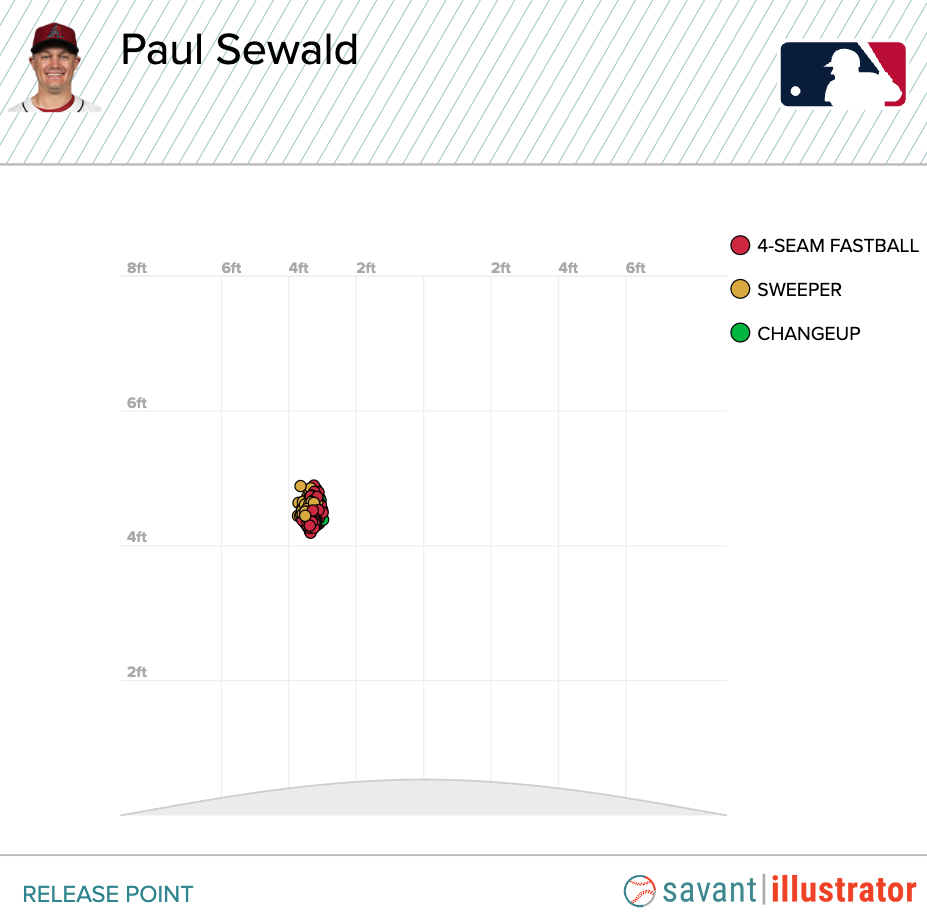
Sewald forces his heavily used (64% usage) four-seam fastball for strikes over 71% of the time (83rd percentile), with a decent swinging-strike rate (12%). Last season, he paired a 28% whiff rate with a 31% hard-hit rate allowed on the four-seam, resulting in a +7 Run Value.
If you can’t earn ride or velo on your fastball, throw it flat. Pitchers with unimpressive stuff but lower arm slots can produce flatter approach fastballs toward the top of the zone, which can help the pitch play better and generate more whiffs.
More Examples – Good and Bad
Another great example of this phenomenon is JP Sears.
Sears uses his four-seam fastball about a third of the time (32% usage), throwing it 92 mph with a 13-inch iVB, resulting in a pedestrian 80 Stuff+ mark on the pitch. But he also has the lowest release point of any pitcher in baseball (min. 1000 pitches thrown), at just 4.8 feet.
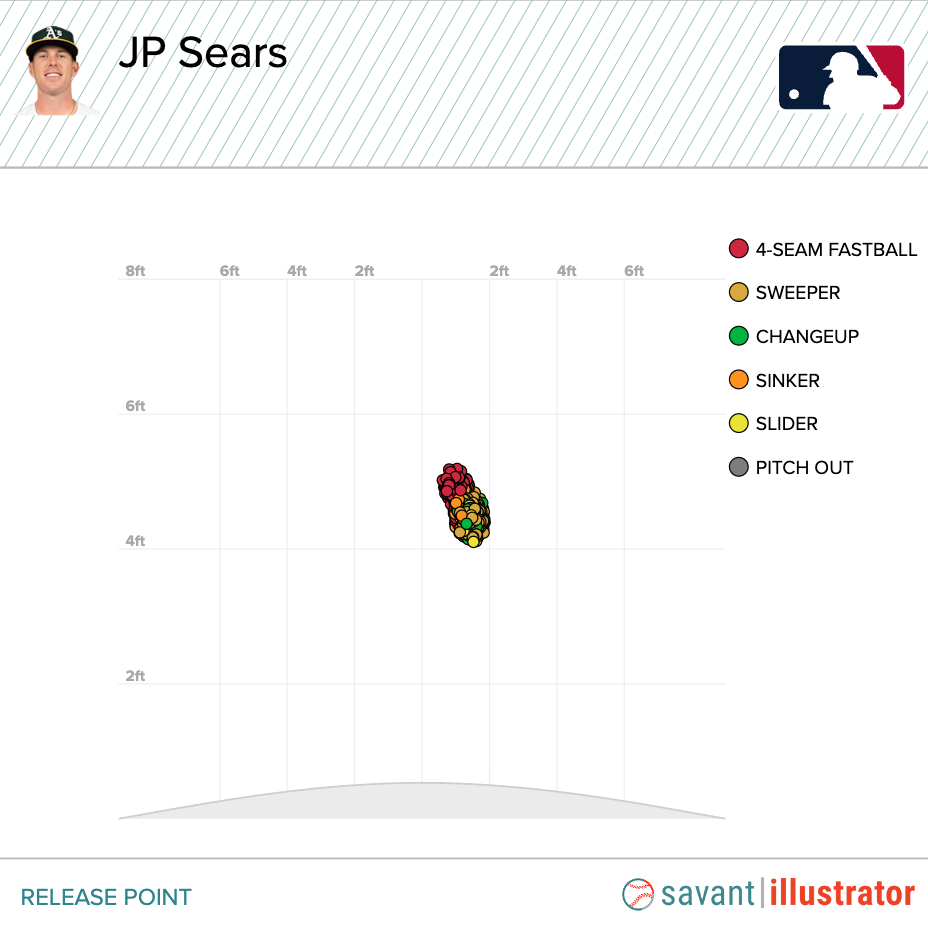
He also keeps his fastball in the upper third of the zone around 56% of the time, which is well above average (68th percentile). As such, he also has among the flattest average four-seam fastball VAAs in the game, a measly -3.8 degrees (99th percentile) – a mark just above the top of the estimated strike zone.
How is that working out for him? Not bad! Sears’ fastball sports a 25% whiff rate (79th percentile) and 13% swinging-strike rate (81st percentile). It could be better on contact, but it’s generating whiffs. And, as expected, he’s been borderline-dominant when keeping his fastball elevated toward the upper third of the zone.
But this rule is not hard and fast. Take John Schrieber, a reliever with a low-velocity (93 mph), low-stuff (7-inch iVB, 80 Stuff+) fastball that he throws from a 4.1-foot release point.
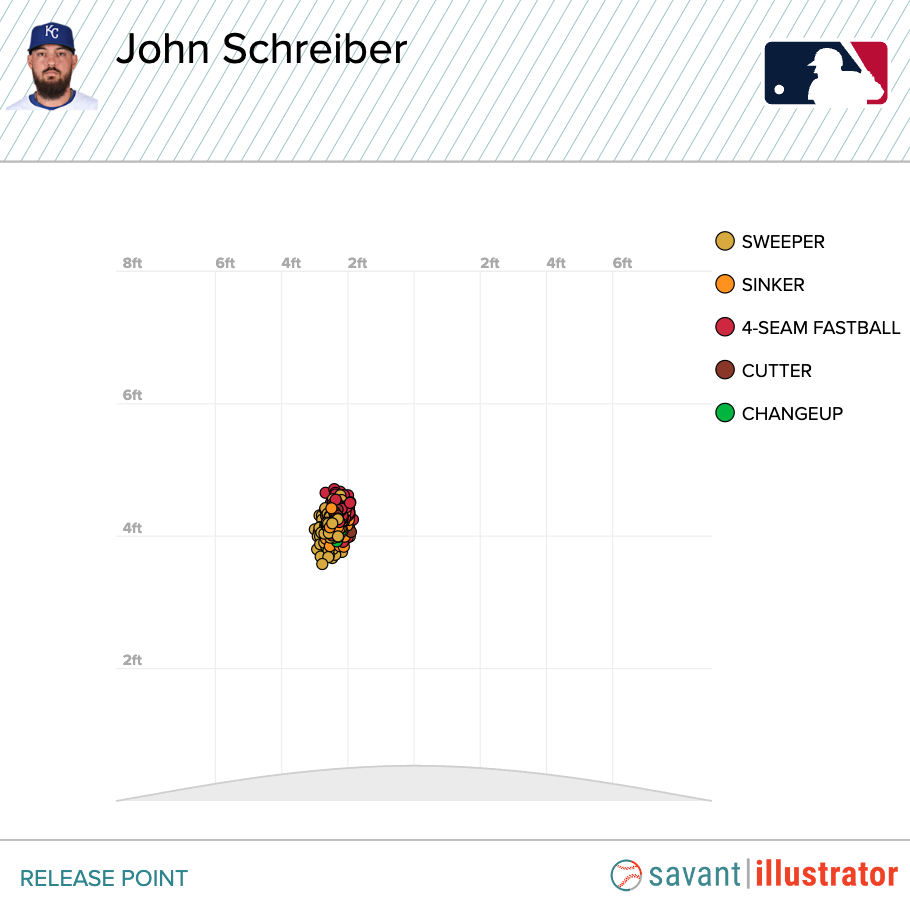
His fastball comes in with a near-perfect -4.0-degree VAA, so you’d expect he could generate whiffs with a flat fastball.
Nope. Schrieber sports a pathetic 7% swinging-strike rate (17th percentile) and 18% whiff rate (28th percentile) on the four-seam. Opposing batters are hitting .333 off the pitch with a .432 wOBA.
What’s the problem?
Schreiber’s best season was in 2022 with the Red Sox, where he pitched to a 2.22 ERA across 65 innings. While he’s a sinker-sweeper pitcher first, he earned an 18% swinging strike on a 28% four-seam fastball usage that year.
The difference was his location. As Schreiber’s high-location rate dipped, so did his VAA, drastically decreasing whiffs, strikeouts, and overall fastball effectiveness.
Remember: A high VAA (read: flat) is good for high fastballs, while a low VAA (read: steep) is good for low fastballs. Schreiber is currently throwing too many flat fastballs middle-middle or down in the zone, and that’s not how The Art Of The Flat Fastball works.
Flat fastballs play up at the top of the zone but won’t play in the bottom two-thirds. I guess this article is just another broad argument for controlling the top of the zone.
Photos by Bob Kupbens/Icon Sportswire, Photo by Brian Rothmuller/Icon Sportswire
